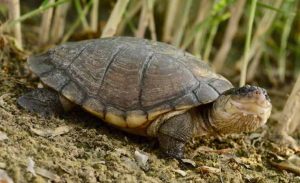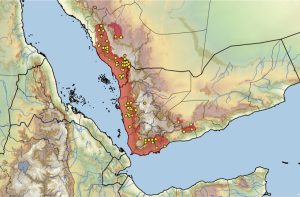Pelomedusa barbata, 118
Pelomedusa barbata Petzold, Vargas-Ramírez, Kehlmaier, Vamberger,
Branch, Du Preez, Hofmeyr, Meyer, Schleicher, Široký, and Fritz 2014 –
Arabian Helmeted Turtle, Arabian Marsh Turtle, Arabian Mud Turtle
Johannes Els1, Abdulaziz R. Alqahtani2, Uwe Fritz3, Mohammed Shobrak4,
Salem M. Busais5, and Bernat Burriel-Carranza6
1Breeding Centre for Endangered Arabian Wildlife/ Environment and Protected Areas Authority,
Sharjah, United Arab Emirates [[email protected]];
2Department of Biology, Faculty of Science, University of Bisha, Saudi Arabia [[email protected]];
3Museum of Zoology, Senckenberg Natural History Collections Dresden,
Dresden, Germany [[email protected]];
4Biology Department, Science College, Taif University, Taif, Saudi Arabia [[email protected]];
5Department of Biology, Aden University, Aden, Yemen [[email protected]];
6Institute of Evolutionary Biology (CSIC-Universitat Pompeu Fabra), Passeig Marítim de la Barceloneta, Barcelona, Spain [[email protected]]
Summary. – The Arabian Helmeted Turtle, Pelomedusa barbata (family Pelomedusidae), is a medium-sized, hard-shelled freshwater turtle with a carapace length of up to 216 mm, perhaps 250 mm, and an average adult weight of 800 g. It is characterized by having two small temporal scales on each side of the head and two large barbels located under the chin. The species is endemic to the Arabian Peninsula and occurs in scattered, often isolated populations throughout its range in Saudi Arabia and Yemen. It occupies well-vegetated habitats at elevations from sea level to 1800 m, in basalt- and granite-rock formations that allow the accumulation of surface water within higher rainfall areas as compared to the drier interior of the Arabian Peninsula. Females lay a clutch of 6–11 leathery-shelled eggs that hatch after 50–70 days of incubation. Ontogenetic color changes occur on both the carapace and plastron. The species is threatened by overexploitation of surface water and habitat destruction and is likely to be further impacted by climate change.
Distribution. – Saudi Arabia and Yemen. Occurs in southwestern Saudi Arabia in the Asir Mountain range in Al-Behah, Asir, Jizan, and Makkah provinces, and in western and southwestern Yemen within the mountainous regions of Abyan, Adh-Dali, Al-Hudaida, Lahij, Shabwa, and Taiz governorates.
Synonymy. – Pelomedusa barbata Petzold, Vargas-Ramírez, Kehlmaier, Vamberger, Branch, Du Preez, Hofmeyr, Meyer, Schleicher, Široký, and Fritz 2014. Previously considered part of Pelomedusa subrufa (Bonnaterre 1789).
Subspecies. – No subspecies recognized.
Status. – IUCN 2021 Red List: Not Evaluated (NE); TFTSG Provisional Red List: Endangered (EN, assessed 2016); CITES: Not listed.
Citation:
Els, J., Alqahtani, A.R., Fritz, U., Shobrak, M., Busais, S.M., and Burriel-Carranza, B. 2022. Pelomedusa barbata Petzold, Vargas-Ramírez, Kehlmaier, Vamberger, Branch, Du Preez, Hofmeyr, Meyer, Schleicher, Široký, and Fritz 2014 – Arabian Helmeted Turtle, Arabian Marsh Turtle, Arabian Mud Turtle. In: Rhodin, A.G.J., Iverson, J.B., van Dijk, P.P., Stanford, C.B., Goode, E.V., Buhlmann, K.A., and Mittermeier, R.A. (Eds.). Conservation Biology of Freshwater Turtles and Tortoises: A Compilation Project of the IUCN/SSC Tortoise and Freshwater Turtle Specialist Group. Chelonian Research Monographs 5(16):118.1–10. doi: 10.3854/crm.5.118.barbata.v1.2022; www.iucn-tftsg.org/cbftt/.
Adobe Acrobat 6.0 or later required)

Adult Pelomedusa barbata, Taif, Makkah Province, Saudi Arabia.
Photo by Johannes Els.
Distribution:
Distribution of Pelomedusa barbata on the Arabian Peninsula in southwestern Saudi Arabia and Yemen. Yellow dots = museum and literature occurrence records of native populations based on Iverson (1992), Gasperetti et al. (1993), Alqahtani (2017), other literature sources, and authors’ data; orange dots = possible trade or inaccurately reported specimens. Distribution based on GIS-defined level 12 HUCs (hydrologic unit compartments) constructed around verified localities and then adding HUCs that connect known point localities in the same watershed or physiographic region, and similar habitats and elevations as verified HUCs (Buhlmann et al. 2009; TTWG 2021), and adjusted based on data from authors’ and other sources.









